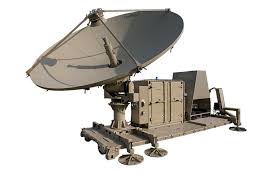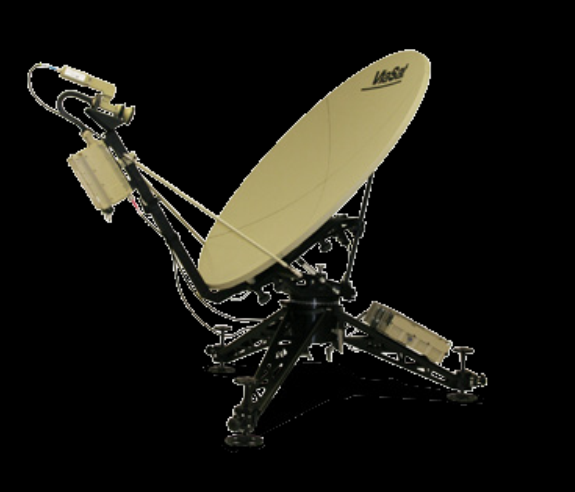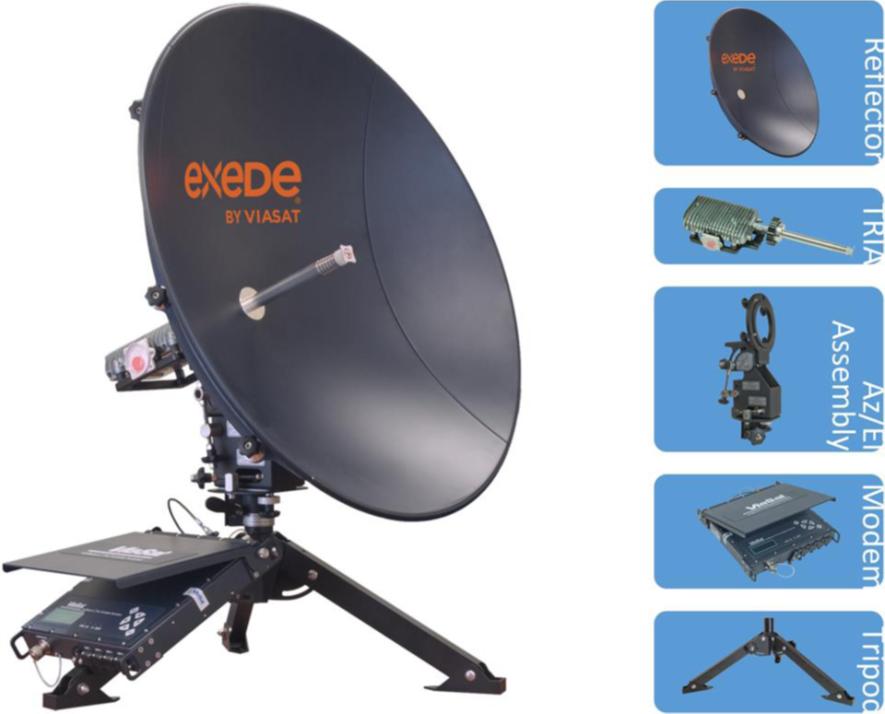Satellite Broadband Terminals |
| (Satellite Internet Ground Systems, Satellite Internet Systems ) |
 |
Although satellite phones can be used to send text messages and small email files they are not suitable for transmitting or receiving large files due to their very low data rates. Satellite broadband terminals are small portable devices which, together with your laptop computer, enable you to connect to the internet with broadband speeds virtually anywhere on the planet. They allow you to keep in contact with friends and family through email, blogs or social networking sites and stream live video wherever you travel, no matter how remote that region may be. Some terminals also allow voice connectivity to enable you to make phones calls using a specially designed handset. The complete terminal includes a transmit-receive antenna, an indoor unit (IDU) similar to a typical cable or DSL modem, and an outdoor unit (ODU) similar to a dish for satellite television reception. The terminal enables fast web browsing at DSL-like speeds and supports video streaming, file sharing, and bandwidth-intensive Internet applications. The network operator can define lower classes of service using provisioning tools to configure the terminal for lower downstream and upstream speeds. The satellite terminal uses a modified version of the Wi-Max Protocol. The forward channel works on DVB S2, but the return one works on MF-TDMA ("Multi-frequency time-division multiple access") . The terminal is part of a complete system that also includes an innovative Satellite Modem Termination System (SMTS) gateway and Network Management Systems (NMS) that facilitate subscriber management with features such as automated service provisioning, diagnostics, and customer support. |
|
|
|
Which satellite terminal best suits my needs?There are various satellite terminals to choose from and the one most suitable for you will vary depending on a number of factors including budget, size, required data or streaming speed and the number of users sharing the terminal. With the wide range of capabilities and options offered by different types of terminals, choosing the right platform for your IP satellite communication is essential to ensure you have a system that will be able to fully support your organization’s needs. Currently, there are four popular, reliable options available: 1) Inmarsat’s BGAN (Broadband Global Area Network), FBB or Fleet Broadband for Maritime and for Aviation SBB or Swift Broadband, The Inmarsat BGAN network offers near global coverage and is generally a more popular choice due to the wider range of terminals and airtime options. Terminals range from the entry level IsatHub, a very capable terminal capable of providing data download speed of up to 384 kbps, to the Cobham Explorer 710, the biggest and fastest satellite terminal available. This terminal offers data connection speeds of up to 492 kbps along with the ability for multiple users to send and receive data and make voice calls all at the same time. The preferred terminals for the majority of users are the IsatHub or Cobham Explorer 510 terminals. BGAN, Fleet Broadband and Swift Broadband offers seamless coverage on land or sea for the majority of the globe – with the caveat that it must be in the line of sight with one of Inmarsat’s three geosynchronous satellites. Due to this requirement, there is no data coverage at the polar regions. There also can’t be anything obstructing the line of sight to the satellites, so they often tend to be used outdoors or through unobstructed windows. If you plan to use the platform mainly for office applications, such as email, small data transfers, web-browsing, phone support, and VPN access, the BGAN may be sufficient for your needs. It also supports telemetry and short-term video broadcasts. The BGAN can transmit data at speeds of up to 500 kbps and is generally designed for single users or a small team that has sporadic data usage throughout the day. If you’re interested in selecting a portable, easy to set-up and use terminal, the BGAN is a great choice. It’s small, lightweight, and battery-powered. The BGAN is incredibly user-friendly and doesn’t require a technician for setup, making it simple to have your mobile office-ready in a matter of minutes. It does require that you manually point it at the satellite; however, it’s easy to do. The BGAN’s portability and on-the-go setup make it favorable for applications like war zone broadcasts, remote regions, and sporting events. Inmarsat makes about 18 different types of BGAN terminals, many of which are small enough to fit inside of a laptop case. BGAN antennas range from $3,000 to $5,000; auto-tracking units cost anywhere from $8,000 to $18,000. 2) VSAT (Very Small Aperture Terminal) The VSAT is a choice for those who need high bandwidth to transmit high levels of data on a long term basis. It can carry data as well as latency-sensitive applications and IP based multicast applications like audio and video streaming. The VSAT can provide point-to-point WAN links and is capable of “always on” broadband internet services; it also supports bandwidth on-demand services, encrypted data transfers between two or more sites, and VPNs. The VSAT platform supports dozens of users with upload speeds of up to 5 Mbps and download speeds of up to 20 Mbps. The VSAT terminal can back up to terrestrial networks or can utilize customized plans to backup exclusively with satellite service providers. The VSAT is extremely reliable and not affected by natural disasters, making it an excellent option for mission-critical applications. Rain attenuation may affect its performance, so larger antennas and amplifiers are usually recommended for some applications. The VSAT terminal requires a technician to handle the installation, so it’s important to keep in mind that there will be additional costs for it to be fixed-site installed for In-Building communications. It’s a small dish antenna that stays in place, so it’s not portable once installed. Deployment can be done in any region within hours. VSAT costs can vary greatly depending on several factors, including the type of equipment you choose. Entry-level equipment starts at $3,000 but can run up to tens of thousands of dollars for larger-scale operations. Auto pointing systems can cost anywhere from $20,000 to $200,000 depending on the type of system. 3) Iridium’s Certus The Certus offers high throughput L-band data speeds for simultaneous connections of data access, multiple phone lines, and location-based applications. Its low-latency network provides consistent smartphone use anywhere around the globe. Certus allows you to automatically route data connection through an external cellular modem when networks are available to help reduce the cost and provide a seamless user experience. It initially launches with speeds of up to 352 kbps but can be upgraded to 704 kbps and potentially reach a maximum 1408 kbps. Certus can be used as primary broadband or as a backup to an existing VSAT. The Certus terminal features a low-frequency I-band signal that is unaffected by weather conditions. Certus offers pole-to-pole coverage and will soon be providing narrowband voice and data capabilities for ships, aircraft, vehicles, and IoT devices. Iridium’s Certus is lightweight, straightforward to set up and easy to use; it has a solid-state omni-directional antenna that automatically connects with the closest Iridium satellite. Certus terminals can range from about $7,000 to $9,000 depending on the equipment. 4)Thuraya The Thuraya network offers more flexibility with its airtime options and is a good choice if you do not want to be tied into a long contract as it offers a one month minimum term. Thuraya airtime is priced very competitively and also offer contracts with unlimited data use and so can end up being more cost effective in the long term. If you decide that the Thuraya network is the most suitable for your needs, there are two terminals available; the Thuraya IP terminal and the Thuraya IP+. They are ultra-light weight and compact satellite terminals and provide high-speed streaming capabilities. These convenient 'always-on' terminals enable fast, reliable data connectivity even from the most remote regions across more than 140 countries in Asia, Australia, Africa, the Middle East and Europe. All four of these systems provide reliable voice and data applications from remote locations, however, each one has different specifications in terms of data volumes, size, cost, and ease of use. Essentially, your decision between platforms should be made with consideration to which one will best suit your organization’s needs. |

